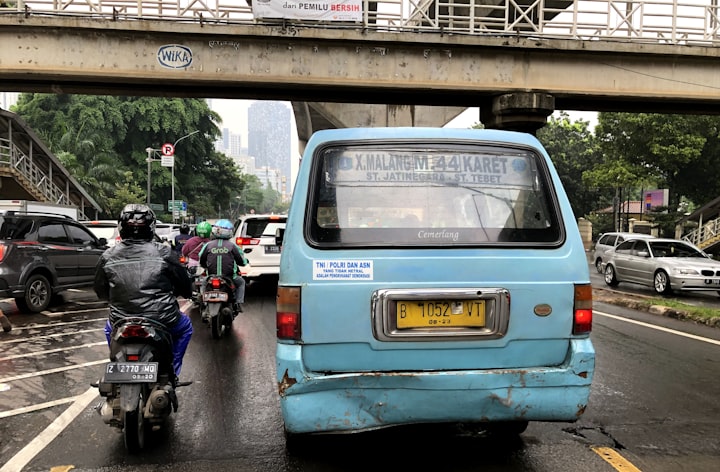Angkot Away
What you need to learn about Indonesia's worst and best transport system

If you ask anyone about my country, Indonesia, almost everyone would mention Bali-as if it’s the only place in the archipelago-or the pristine beaches and amazing cuisine. The richness of culture allows one to explore unforgettable journeys and exotic flavors--the best things in the country. But, you never truly experience Indonesia if you haven’t experienced the worst.
Having been in some of the most touristy and crowded cities like Jakarta and Bandung, I can safely say that city transport is, perhaps, the worst. A system that is anything but reliable, and nothing but chaotic.
There are basically three types of land transports in the country: trains, buses, and mini-buses or what we call angkot (literally means ‘city transport’). We use the first two for inter-city travels and angkots for inner-city trips. Trains and buses are relatively dependable, affordable, and somewhat organized. In fact, these public services have shown considerable improvement since train and bus companies decided to review their practices and make significant changes in many aspects: quality of vehicles, official rates, booking system, and, most importantly, order and security. Financial repercussions on minor to major violations were reinforced, and they worked like a charm. They placed security guard posts; installed automatic ticket machines; and successfully raised people’s awareness in general order. Things have never seemed better.
With angkots, however, things have never seemed worse. They’ve been around for as long as I remember, but it’s never clear to which organization they actually belong. Every city has its own range of angkots owned by multiple parties covering numerous, at times overlapping, routes. In Bandung alone, there are more than 35 routes, and depending on the route, each vehicle is marked with seemingly random numbers and a specific combination of colors. With no designated stops nor information about the actual route, trying to remember which angkot to take can be a nightmare. Local people survive having lived in the city all their lives, but if you come from a different country or even the neighboring cities, you should be prepared to lose your way.
Another disturbing fact is the lack of driving competence and the abundance of vehicles with appalling road-worthiness--a perfect cocktail for danger. There are a number of newer vehicles, but most should really be in a museum. Old tires, broken lights, absence of safety belts, and even defective brakes are common to see. To make things (even) worse, Indonesia’s driving tests are very lax and run by the police departments infamous for offering “fast service” where people can avoid the queue and attain a license in less than 30 minutes. All this amounts to drivers who are either illegal or careless. And the road accidents caused by this factor are too many to mention. Every other day there’d be news about angkot crashes due to reckless driving, which is frankly getting old. I remember feeling horrified watching the news about an angkot driver who sped through a railroad, despite the warnings of an incoming train, and was stuck in the middle because the engine suddenly stopped. Eight lives vanished just like that.
Thinking in retrospect, I always had a sense of frustration traveling with angkots, but the feeling was awfully intensified after returning from a 3-year work placement abroad. It was unpleasantly shocking to see how dire the road condition was. Most of the cars are still in the same state they were three years ago. The quality of drivers, driving, and attitude remain the same, if not worse.
The first few weeks after my return, I was drowned in stress having to travel by angkots. The sense of annoyance was just palpable. One time, I had to wait for other passengers to fill up the seats before the driver started the journey, and when he did, he didn’t hesitate to hit the brake whenever he felt like it, whenever there were potential passengers for which he would gladly drive in reverse! At some point, he pulled over at a small car repair shop to check on the tires, which were probably flat, and, while waiting for the mechanic to do the job, decided to have a coffee break. This was the peak of my frustration, and as I tried to keep my cool, I got off the angkot, gave him the money and walked away. At last, I was free.
There is an endless list of complaints I can say about these angkots: the inconsistent fare, cigarette smoke (yes, they smoke in public), rude drivers, and the potential risk of accidents are just the tip of the iceberg. I often ask myself why I still take these rides and bear with the inconvenience. And the answer is simply because there are no other options. It’s either angkots or more expensive taxi- and Uber-like rides, which would obviously swell up travel expenses.
It’s disturbing to know that you’re stuck with this type of transport for an indefinite time, and the chance of having better mass transport is slim to none. The government has recently talked about building a Light Rail Transit system which, I suppose, would have connecting trams to travel in and around the city. This is surely appealing in theory, but I often wonder why the government would choose to build a brand-new type of transport from scratch than to improve the currently existing one. Why not tighten the driving tests for angkot drivers instead? Why can’t we cut down the number of routes and vehicles? Why not provide route maps for passengers? Why don’t we have a system where all drivers are officially registered and supervised?
In the midst of despair, however, I found a tiny glimmer of hope. According to The Economist, Indonesia is predicted to flourish in the economy sector due to the fact that 70% of the massive population is under 30 years old. That’s about 140 million people. And from this young generation, there’s one who’s made a name for himself. Possibly driven by the same despair that I (and a million others) feel, Nadiem Makarim, a young entrepreneur, decided to take matters into his own hands. In 2010, he started a company of an online-based service that offers alternative land transport using motorbikes. Traditionally, these motorbikes, called ojek, are only available within housing complexes and run by local neighborhoods. With a catchy name, Go-Jek, the Harvard graduate adapted the concept of Uber and applied it to an existing, slightly unexplored, land transport now accessible for anyone with a smartphone.
It takes a second to download the App, fill out an information page, and link your phone number. Voila! You’re ready to go. Next, you type the destination and pick-up place located on the GPS and agree to the price generated. In a blink of an eye, a driver (or rider, in this case) will give you a confirmation text or call. When they arrive at your door, they provide you with a safety helmet and a protective mask, though the latter is not always appealing for passengers. In less than 10 minutes, you’re already on your way to any place you desire. Forget the waiting, forget the incessant brake-hitting, forget the coffee-sipping driver.
This service proves to be an answer to a lot of prayers. And as it grows in popularity, it grows in credibility. All Go-Jek riders are carefully screened and required to fulfill a series of requirements before officially employed, arguably making them more trustworthy. Customers are given the option to rate the riders after service, and the riders might receive a bonus if they have good reviews. With a range of attractive services they offer such as Go-food (food delivery) and Go-mart (grocery shopping), plus a reasonable price, Go-Jek has been one of the most dependable ways to get around and get things done.
Nevertheless, the issue of angkots remains alive. Despite all the wonderful, existing and upcoming development of other transport services, the reality is that nothing has been or would be done with the disorderly mass of angkots. Deep down in my heart, I have faith in some sort of progress, some form of organization, some kind of solution. But I constantly wonder if I should cling to this seemingly empty hope. Hope for a time when the government attempts to resolve this issue, down to the nitty-gritty, as they should have. Or perhaps all we need to do is wait for other “heroes” like Nadiem Makarim to come and save us.
I truly wish for the former.






Comments
There are no comments for this story
Be the first to respond and start the conversation.